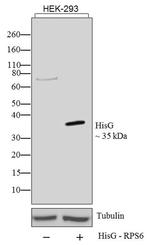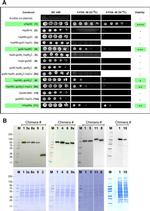Invitrogen
HisG Epitope Tag Monoclonal Antibody, HRP
FIGURE: 1 / 3
HisG Epitope Tag Antibody (R941-25) in WB



Product Details
R941-25
Species Reactivity
Published species
Host/Isotype
Class
Type
Immunogen
Conjugate
Form
Purification
Storage buffer
Contains
Storage conditions
RRID
Product Specific Information
NOTE: R941-25 was previously sold under product #46-1009. When re-ordering, please use #R941-25.
This antibody is designed to specifically detect recombinant proteins containing the seven amino acid 6xHis-Gly epitope. This epitope is present in many expression vectors encoding an N-terminal 6xHis tag. The HisG antibody recognizes the following sequence: -His-His-His-His-His-His-Gly and can be used to detect expression of fusion proteins from bacterial, insect, and mammalian cells.
Anti-HisG-HRP Antibody was prepared by crosslinking the Anti-HisG Antibody with horseradish peroxidase using glutaraldehyde. It has been tested in immunoblotting and ELISA procedures. It was tested against purified Positope™ control protein (5 ng). The Positope™ control protein is a 53 kDa recombinant protein that contains seven epitope tags, including His(C-term), HisG, c-Myc, and V5. Low background was observed using chemiluminescent or alkaline phosphatase reagents for detection. In western blot experiments with purified protein, 50 ng (for Anti-HisG-HRP Antibody) of the Positope protein gave a detectable signal.
For western blot, dilute in PBS containing 0.05% Tween-20 and 5% nonfat, dry milk (PBSTM). Using chemiluminescence as the detection method, no cross-reactivity has been observed in bacterial lysates. In mammalian lysates, a few cross-reactive proteins have been observed upon overexposure of blots. If you use alkaline phosphatase-conjugated secondary antibody, do not use PBS. Phosphate inhibits alkaline phosphatase. Use Tris-Buffered Saline (TBS) instead. Be sure to wash the western blot or microtiter wells before adding the horseradish peroxidase-conjugated secondary antibody. Azide will inhibit HRP activity. This product contains enough material for 25 western blots; assumes 10 mL buffer per western blot.
Target Information
Epitope tags provide a method to localize gene products in a variety of cell types, study the topology of proteins and protein complexes, identify associated proteins, and characterize newly identified, low abundance or poorly immunogenic proteins when protein specific antibodies are not available. Expression of recombinant proteins in E. coli as a fusion protein with neighboring histidine residues is one of the most popular methods of epitope tags. The affinity of the histidine-tag motif to Ni2+ by chelation is strong and selective enough to enable purification of the protein to homogeneity by affinity chromatography on a Ni2+-NTA adsorbent. HisG antibodies allow detection of recombinant proteins containing a polyhistidine sequence: His-His-His-His-His-His-Gly (6xHis-Gly epitope). HisG antibodies can be used to detect expression of fusion proteins from bacterial, insect, and mammalian cells.
For Research Use Only. Not for use in diagnostic procedures. Not for resale without express authorization.
Bioinformatics
Protein Aliases: 6xHis-Gly; 6xHis-Glycine; His G; His Tag; Histidine Tag

Performance Guarantee
If an Invitrogen™ antibody doesn't perform as described on our website or datasheet,we'll replace the product at no cost to you, or provide you with a credit for a future purchase.*
Learn more
We're here to help
Get expert recommendations for common problems or connect directly with an on staff expert for technical assistance related to applications, equipment and general product use.
Contact tech support
